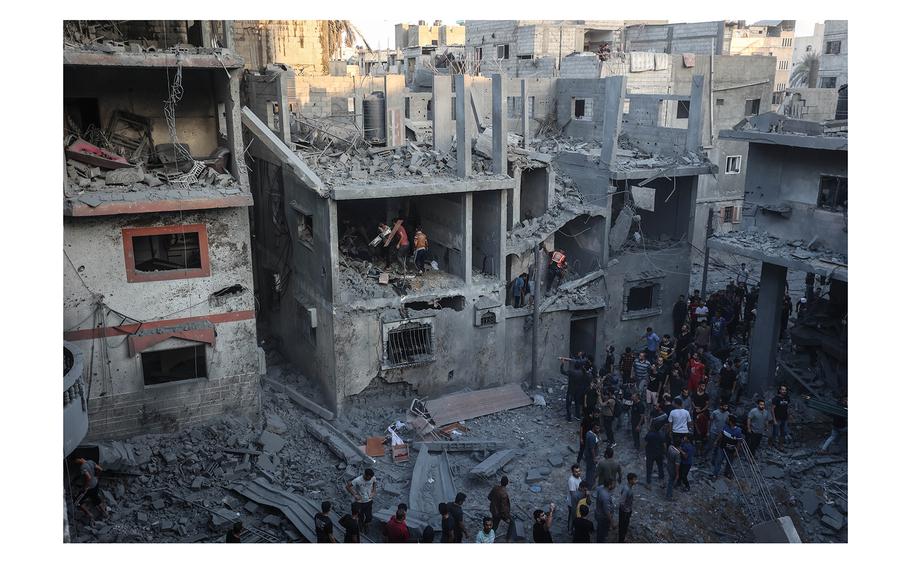
Palestinians inspect the damage caused by an Israeli strike on a house in Khan Younis, in southern Gaza, on Thursday, Oct. 19, 2023. (Loay Ayyoub for The Washington Post)
U.S. intelligence officials said Tuesday they have determined with “high confidence” that Israel was not responsible for the huge explosion at al-Ahli Hospital in Gaza City that killed scores of people last week, offering the most detailed explanation to date of an apparent accident that sparked protests throughout the Middle East after some initial reports attributed responsibility to Israel.
The intelligence community reached its conclusion after examining multiple videos and using geolocation techniques to trace the Oct. 17 blast to a rocket launched inside Gaza that suffered a mechanical failure midflight before crashing into the hospital, three officials said. They spoke to reporters on the condition of anonymity under ground rules set by the government.
Analysts are unable to say for sure who launched the rocket, because of a lack of information that conclusively points to the culprit, the officials said. They have examined intercepted communications of fighters affiliated with Hamas, who can be heard speculating that Palestinian fighters were responsible for the rocket strike, one U.S. official said. The communication, which was provided to the United States by the Israeli government, is different from a recording that the Israel Defense Forces released publicly, the official noted.
But absent other points of information and supporting material, analysts could only conclude with “low confidence” that Palestinian fighters were responsible.
Soon after the strike, Biden administration officials and members of Congress moved quickly to say Israel was not to blame, pointing to intelligence analysis that indicated, they said, the explosion was the result of an errant Palestinian rocket.
The ultimate assessment that the strike was not the result of an Israeli weapon was based on two primary factors, the officials said. First, the damage from the strike was consistent with a rocket, and not an Israeli munition, such as a bomb dropped from the air or an artillery round, which would have caused significant structural damage to the hospital building and left a large crater. Videos and images show “only light structural damage,” one of the officials said.
Second, analysts were able to track the trajectory based on videos shot from four locations. Two cameras captured the flight of the projectile, which analysts judge to have been launched within the Gaza Strip, the official said. The rocket then traveled northeast, and about 10 seconds after launch, the motor became unstable, the official said. The rocket’s plume fluctuated in intensity, and a few seconds later, analysts observed a large flash. That, the official said, was the motor failing.
As a result of the failure, the rocket changed direction, the official said. The rocket came apart and the motor struck the ground, followed by the warhead, which landed at the hospital and caused a large explosion, the official said.
In the days since the strike, analysts have scoured open sources looking for any debris at the site that might tie the projectile to Israel, but they have found none, the official said. No Palestinians have come forward with such evidence as they would be expected to do if they had proof that Israel was to blame, the official added.
The reported number of casualties from the strike has varied widely. The officials said that they were unable to offer a definitive number but have not moved beyond a previous estimate that the strike killed between 100 and 300 people.
In trying to definitively attribute the strike to Palestinian actors, U.S. analysts have relied on scant information compared with what they’ve been able to discover about the launch and impact of the rocket. Using intercepted communications, they examined the statements and language patterns of the speakers and determined that they were “affiliated” with Hamas, one of the officials said. In the recordings, those individuals appeared to agree that the rocket was launched by Palestinian Islamic Jihad, but without more conclusive information, analysts could not get beyond a “low confidence” assessment.
“We judge it to be reliable and authentic,” but on its own the communication intercept was insufficient to more firmly attribute the rocket launch to Islamic Jihad, the official said.